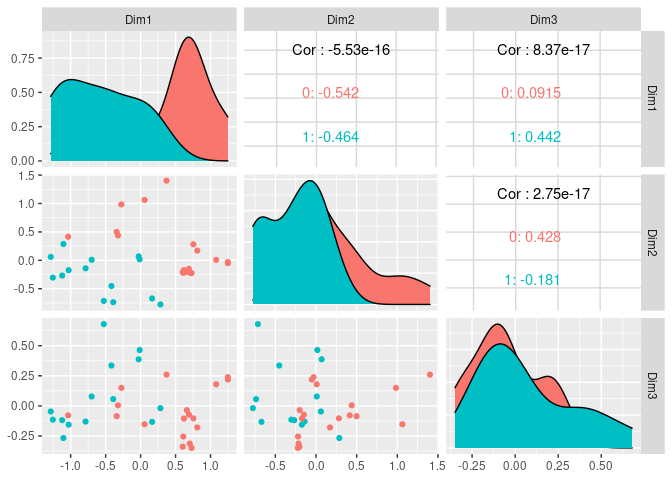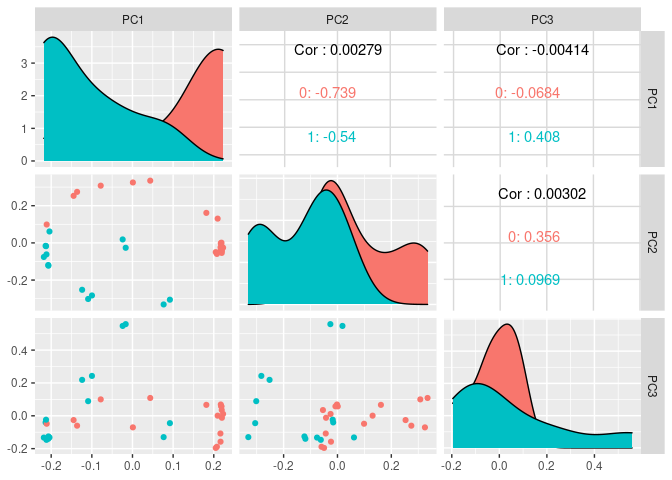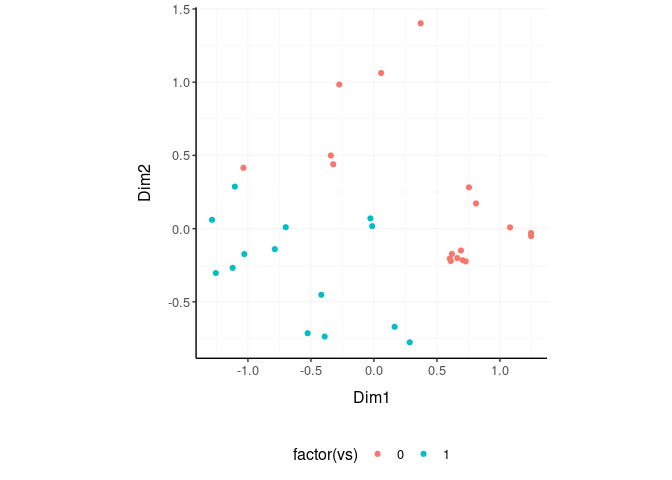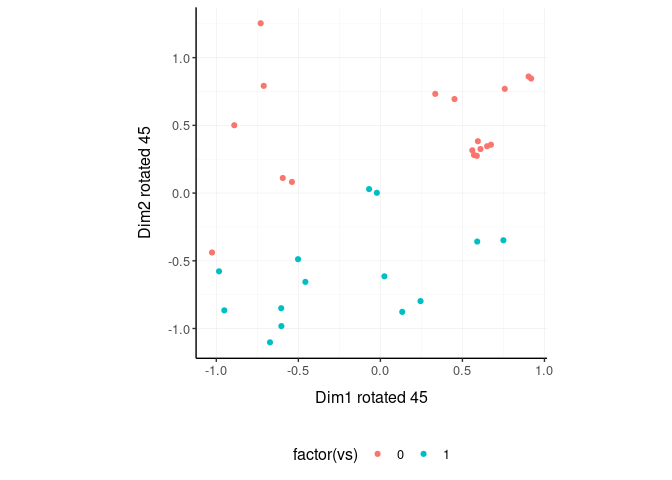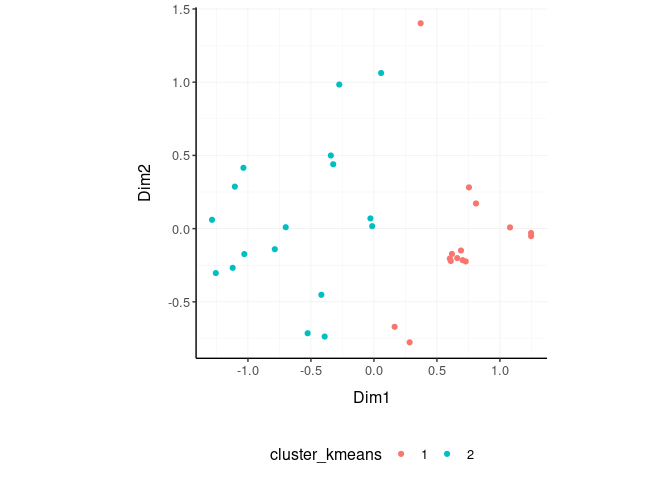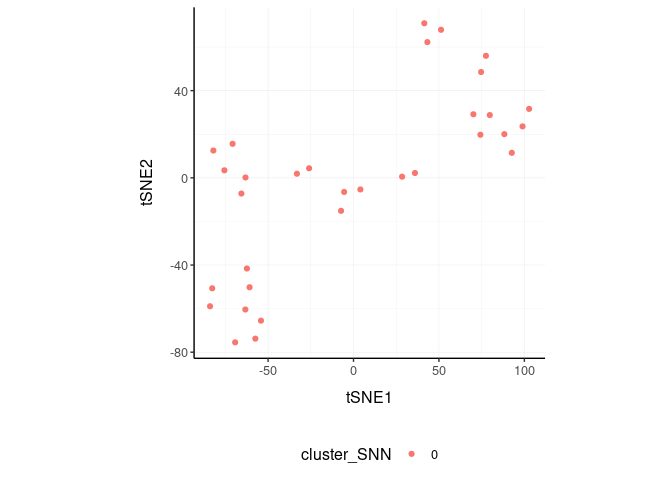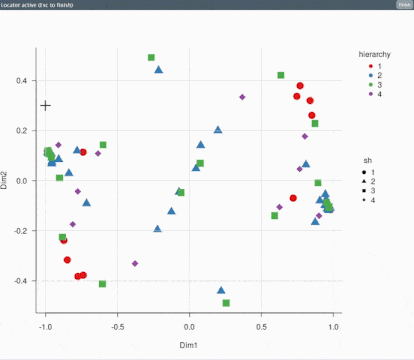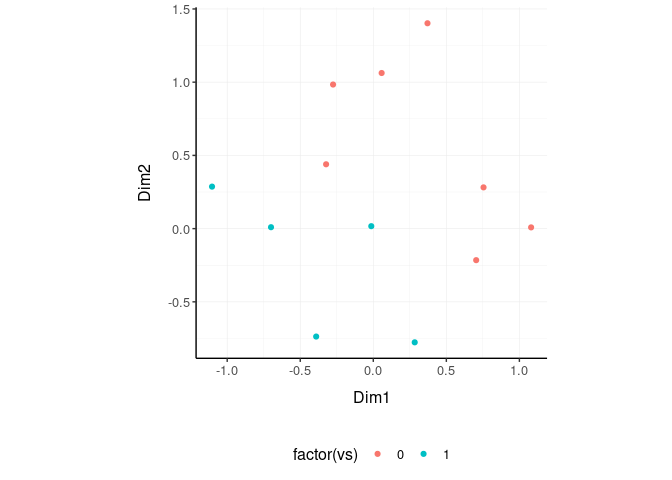This repository is no longer maintained and superseeded by tidybulk
It tidies up your playground!
Please have a look also to
- tidygate for adding custom gate information to your tibble
- tidyHeatmap for heatmaps produced with tidy principles
- tidybulk brings transcriptomics to the tidyverse
It does a lot! cluster, PCA, permute, impute, rotate, redundancy-removal, triangular, smart-subset, identify abundant and variable features.
| Function | Description |
|---|---|
reduce_dimensions |
Perform dimensionality reduction (PCA, MDS, tSNE) |
rotate_dimensions |
Rotate two dimensions of a degree |
cluster_elements |
Labels elements with cluster identity |
remove_redundancy |
Filter out elements with highly correlated features |
fill_missing |
Fill values of missing element/feature pairs |
impute_missing |
Impute values of missing element/feature pairs |
permute_nest |
From one column build a two permuted columns with nested information |
combine_nest |
From one column build a two combination columns with nested information |
keep_variable |
Keep top variable features |
lower_triangular |
keep rows corresponding to a lower triangular matrix |
| Utilities | Description |
|---|---|
as_matrix |
Robustly convert a tibble to matrix |
subset |
Select columns with information relative to a column of interest |
| element | feature | value |
|---|---|---|
chr or fctr |
chr or fctr |
numeric |
| element | feature | value | new information |
|---|---|---|---|
chr or fctr |
chr or fctr |
numeric |
… |
devtools::install_github("stemangiola/nanny")nanny is a collection of wrapper functions for high level data analysis and manipulation following the tidy paradigm.
mtcars_tidy =
mtcars %>%
as_tibble(rownames="car_model") %>%
mutate_at(vars(-car_model,- hp, -vs), scale) %>%
gather(feature, value, -car_model, -hp, -vs)
mtcars_tidy## # A tibble: 288 x 5
## car_model hp vs feature value
## <chr> <dbl> <dbl> <chr> <dbl>
## 1 Mazda RX4 110 0 mpg 0.151
## 2 Mazda RX4 Wag 110 0 mpg 0.151
## 3 Datsun 710 93 1 mpg 0.450
## 4 Hornet 4 Drive 110 1 mpg 0.217
## 5 Hornet Sportabout 175 0 mpg -0.231
## 6 Valiant 105 1 mpg -0.330
## 7 Duster 360 245 0 mpg -0.961
## 8 Merc 240D 62 1 mpg 0.715
## 9 Merc 230 95 1 mpg 0.450
## 10 Merc 280 123 1 mpg -0.148
## # … with 278 more rows
We may want to reduce the dimensions of our data, for example using PCA,
MDS of tSNE algorithms. reduce_dimensions takes a tibble, column names
(as symbols; for element, feature and value) and a method (e.g.,
MDS, PCA or tSNE) as arguments and returns a tibble with additional
columns for the reduced dimensions.
MDS
mtcars_tidy_MDS =
mtcars_tidy %>%
reduce_dimensions(car_model, feature, value, method="MDS", .dims = 3)On the x and y axes axis we have the reduced dimensions 1 to 3, data is coloured by cell type.
mtcars_tidy_MDS %>% subset(car_model) %>% select(contains("Dim"), everything())## # A tibble: 32 x 6
## Dim1 Dim2 Dim3 car_model hp vs
## <dbl> <dbl> <dbl> <chr> <dbl> <dbl>
## 1 -0.342 0.499 -0.0853 Mazda RX4 110 0
## 2 -0.323 0.439 0.00461 Mazda RX4 Wag 110 0
## 3 -0.787 -0.140 -0.130 Datsun 710 93 1
## 4 0.164 -0.670 -0.133 Hornet 4 Drive 110 1
## 5 0.602 -0.205 -0.339 Hornet Sportabout 175 0
## 6 0.284 -0.777 -0.0186 Valiant 105 1
## 7 0.810 0.172 -0.179 Duster 360 245 0
## 8 -0.417 -0.452 0.335 Merc 240D 62 1
## 9 -0.526 -0.715 0.679 Merc 230 95 1
## 10 -0.0277 0.0696 0.387 Merc 280 123 1
## # … with 22 more rows
mtcars_tidy_MDS %>%
subset(car_model) %>%
GGally::ggpairs(columns = 4:6, ggplot2::aes(colour=factor(vs)))PCA
mtcars_tidy_PCA =
mtcars_tidy %>%
reduce_dimensions(car_model, feature, value, method="PCA", .dims = 3)On the x and y axes axis we have the reduced dimensions 1 to 3, data is coloured by cell type.
mtcars_tidy_PCA %>% subset(car_model) %>% select(contains("PC"), everything())## # A tibble: 32 x 6
## PC1 PC2 PC3 car_model hp vs
## <dbl> <dbl> <dbl> <chr> <dbl> <dbl>
## 1 -0.136 0.274 -0.0602 Mazda RX4 110 0
## 2 -0.145 0.253 -0.0261 Mazda RX4 Wag 110 0
## 3 -0.212 -0.0619 -0.146 Datsun 710 93 1
## 4 0.0767 -0.331 -0.130 Hornet 4 Drive 110 1
## 5 0.205 -0.0498 -0.196 Hornet Sportabout 175 0
## 6 0.0920 -0.306 -0.0449 Valiant 105 1
## 7 0.210 0.130 0.000724 Duster 360 245 0
## 8 -0.124 -0.252 0.219 Merc 240D 62 1
## 9 -0.0997 -0.283 0.243 Merc 230 95 1
## 10 -0.0242 0.0185 0.547 Merc 280 123 1
## # … with 22 more rows
mtcars_tidy_PCA %>%
subset(car_model) %>%
GGally::ggpairs(columns = 4:6, ggplot2::aes(colour=factor(vs)))tSNE
mtcars_tidy_tSNE =
mtcars_tidy %>%
reduce_dimensions(car_model, feature, value, method = "tSNE")Plot
mtcars_tidy_tSNE %>%
subset(car_model) %>%
select(contains("tSNE"), everything()) ## # A tibble: 32 x 5
## tSNE1 tSNE2 car_model hp vs
## <dbl> <dbl> <chr> <dbl> <dbl>
## 1 -63.2 0.149 Mazda RX4 110 0
## 2 -65.6 -7.21 Mazda RX4 Wag 110 0
## 3 -60.8 -50.2 Datsun 710 93 1
## 4 28.4 0.525 Hornet 4 Drive 110 1
## 5 98.9 23.6 Hornet Sportabout 175 0
## 6 36.0 2.21 Valiant 105 1
## 7 74.7 48.5 Duster 360 245 0
## 8 -5.49 -6.48 Merc 240D 62 1
## 9 -7.30 -15.1 Merc 230 95 1
## 10 -33.1 1.88 Merc 280 123 1
## # … with 22 more rows
mtcars_tidy_tSNE %>%
subset(car_model) %>%
ggplot(aes(x = `tSNE1`, y = `tSNE2`, color=factor(vs))) + geom_point() + my_themeWe may want to rotate the reduced dimensions (or any two numeric columns
really) of our data, of a set angle. rotate_dimensions takes a tibble,
column names (as symbols; for element, feature and value) and an
angle as arguments and returns a tibble with additional columns for the
rotated dimensions. The rotated dimensions will be added to the original
data set as <NAME OF DIMENSION> rotated <ANGLE> by default, or as
specified in the input arguments.
mtcars_tidy_MDS.rotated =
mtcars_tidy_MDS %>%
rotate_dimensions(`Dim1`, `Dim2`, .element = car_model, rotation_degrees = 45, action="get")Original On the x and y axes axis we have the first two reduced dimensions, data is coloured by cell type.
mtcars_tidy_MDS.rotated %>%
ggplot(aes(x=`Dim1`, y=`Dim2`, color=factor(vs) )) +
geom_point() +
my_themeRotated On the x and y axes axis we have the first two reduced dimensions rotated of 45 degrees, data is coloured by cell type.
mtcars_tidy_MDS.rotated %>%
ggplot(aes(x=`Dim1 rotated 45`, y=`Dim2 rotated 45`, color=factor(vs) )) +
geom_point() +
my_themeWe may want to cluster our data (e.g., using k-means element-wise).
cluster_elements takes as arguments a tibble, column names (as
symbols; for element, feature and value) and returns a tibble with
additional columns for the cluster annotation. At the moment only
k-means clustering is supported, the plan is to introduce more
clustering methods.
k-means
mtcars_tidy_cluster = mtcars_tidy_MDS %>%
cluster_elements(car_model, feature, value, method="kmeans", centers = 2, action="get" )We can add cluster annotation to the MDS dimension reduced data set and plot.
mtcars_tidy_cluster %>%
ggplot(aes(x=`Dim1`, y=`Dim2`, color=cluster_kmeans)) +
geom_point() +
my_themeSNN
mtcars_tidy_SNN =
mtcars_tidy_tSNE %>%
cluster_elements(car_model, feature, value, method = "SNN")We can add cluster annotation to the tSNE dimension reduced data set and plot.
mtcars_tidy_SNN %>%
subset(car_model) %>%
select(contains("tSNE"), everything()) ## # A tibble: 32 x 6
## tSNE1 tSNE2 car_model hp vs cluster_SNN
## <dbl> <dbl> <chr> <dbl> <dbl> <fct>
## 1 -63.2 0.149 Mazda RX4 110 0 0
## 2 -65.6 -7.21 Mazda RX4 Wag 110 0 0
## 3 -60.8 -50.2 Datsun 710 93 1 0
## 4 28.4 0.525 Hornet 4 Drive 110 1 0
## 5 98.9 23.6 Hornet Sportabout 175 0 0
## 6 36.0 2.21 Valiant 105 1 0
## 7 74.7 48.5 Duster 360 245 0 0
## 8 -5.49 -6.48 Merc 240D 62 1 0
## 9 -7.30 -15.1 Merc 230 95 1 0
## 10 -33.1 1.88 Merc 280 123 1 0
## # … with 22 more rows
mtcars_tidy_SNN %>%
subset(car_model) %>%
ggplot(aes(x = `tSNE1`, y = `tSNE2`, color=cluster_SNN)) + geom_point() + my_themegating
mtcars_tidy_MDS %>%
cluster_elements(car_model, c(Dim1, Dim2), method="gate", .color=group)## # A tibble: 288 x 9
## car_model hp vs feature value Dim1 Dim2 Dim3 gate
## <chr> <dbl> <dbl> <chr> <dbl> <dbl> <dbl> <dbl> <chr>
## 1 Merc 280 123 1 mpg -0.148 -0.0277 0.0696 0.387 1
## 2 Merc 280C 123 1 mpg -0.380 -0.0137 0.0166 0.464 1
## 3 Merc 280 123 1 cyl -0.105 -0.0277 0.0696 0.387 1
## 4 Merc 280C 123 1 cyl -0.105 -0.0137 0.0166 0.464 1
## 5 Merc 280 123 1 disp -0.509 -0.0277 0.0696 0.387 1
## 6 Merc 280C 123 1 disp -0.509 -0.0137 0.0166 0.464 1
## 7 Merc 280 123 1 drat 0.605 -0.0277 0.0696 0.387 1
## 8 Merc 280C 123 1 drat 0.605 -0.0137 0.0166 0.464 1
## 9 Merc 280 123 1 wt 0.228 -0.0277 0.0696 0.387 1
## 10 Merc 280C 123 1 wt 0.228 -0.0137 0.0166 0.464 1
## # … with 278 more rows
We may want to remove redundant elements from the original data set
(e.g., elements or features), for example if we want to define cell-type
specific signatures with low element redundancy. remove_redundancy
takes as arguments a tibble, column names (as symbols; for element,
feature and value) and returns a tibble dropped recundant elements
(e.g., elements). Two redundancy estimation approaches are supported:
removal of highly correlated clusters of elements (keeping a representative) with method=“correlation”
mtcars_tidy_non_redundant =
mtcars_tidy_MDS %>%
remove_redundancy(car_model, feature, value)We can visualise how the reduced redundancy with the reduced dimentions look like
mtcars_tidy_non_redundant %>%
subset(car_model) %>%
ggplot(aes(x=`Dim1`, y=`Dim2`, color=factor(vs))) +
geom_point() +
my_themeThis function allows to obtain a rectangular underlying data structure, where every element has one feature, filling missing element/feature pairs with a value of choice (e.g., 0)
We create a non-rectangular data frame
mtcars_tidy_non_rectangular = mtcars_tidy %>% slice(-1)We fill the missing value with the value of 0
mtcars_tidy_non_rectangular %>% fill_missing(car_model, feature, value, fill_with = 0)## # A tibble: 288 x 5
## car_model hp vs feature value
## <chr> <dbl> <dbl> <chr> <dbl>
## 1 Mazda RX4 110 0 mpg 0
## 2 Mazda RX4 Wag 110 0 mpg 0.151
## 3 Datsun 710 93 1 mpg 0.450
## 4 Hornet 4 Drive 110 1 mpg 0.217
## 5 Hornet Sportabout 175 0 mpg -0.231
## 6 Valiant 105 1 mpg -0.330
## 7 Duster 360 245 0 mpg -0.961
## 8 Merc 240D 62 1 mpg 0.715
## 9 Merc 230 95 1 mpg 0.450
## 10 Merc 280 123 1 mpg -0.148
## # … with 278 more rows
This function allows to obtain a rectangular underlying data structure, where every element has one feature, imputig missing element/feature pairs with a function of choice (e.g., median)
We impute the missing value with the a summary value (median by default) according to a grouping
mtcars_tidy_non_rectangular %>% mutate(vs = factor(vs)) %>%
impute_missing( car_model, feature, value, ~ vs) %>%
# Print imputed first
arrange(car_model != "Mazda RX4" | feature != "mpg")## # A tibble: 288 x 5
## car_model hp vs feature value
## <chr> <dbl> <fct> <chr> <dbl>
## 1 Mazda RX4 110 0 mpg -0.762
## 2 Mazda RX4 Wag 110 0 mpg 0.151
## 3 Hornet Sportabout 175 0 mpg -0.231
## 4 Duster 360 245 0 mpg -0.961
## 5 Merc 450SE 180 0 mpg -0.612
## 6 Merc 450SL 180 0 mpg -0.463
## 7 Merc 450SLC 180 0 mpg -0.811
## 8 Cadillac Fleetwood 205 0 mpg -1.61
## 9 Lincoln Continental 215 0 mpg -1.61
## 10 Chrysler Imperial 230 0 mpg -0.894
## # … with 278 more rows
From one column build a two permuted columns with nested information
mtcars_tidy_permuted =
mtcars_tidy %>%
permute_nest(car_model, c(feature,value))
mtcars_tidy_permuted## # A tibble: 992 x 3
## car_model_1 car_model_2 data
## <fct> <fct> <list>
## 1 AMC Javelin Cadillac Fleetwood <tibble [18 × 3]>
## 2 AMC Javelin Camaro Z28 <tibble [18 × 3]>
## 3 AMC Javelin Chrysler Imperial <tibble [18 × 3]>
## 4 AMC Javelin Datsun 710 <tibble [18 × 3]>
## 5 AMC Javelin Dodge Challenger <tibble [18 × 3]>
## 6 AMC Javelin Duster 360 <tibble [18 × 3]>
## 7 AMC Javelin Ferrari Dino <tibble [18 × 3]>
## 8 AMC Javelin Fiat 128 <tibble [18 × 3]>
## 9 AMC Javelin Fiat X1-9 <tibble [18 × 3]>
## 10 AMC Javelin Ford Pantera L <tibble [18 × 3]>
## # … with 982 more rows
From one column build a two combination columns with nested information
mtcars_tidy %>%
combine_nest(car_model, value)## # A tibble: 496 x 3
## car_model_1 car_model_2 data
## <fct> <fct> <list>
## 1 AMC Javelin Cadillac Fleetwood <tibble [18 × 2]>
## 2 AMC Javelin Camaro Z28 <tibble [18 × 2]>
## 3 AMC Javelin Chrysler Imperial <tibble [18 × 2]>
## 4 AMC Javelin Datsun 710 <tibble [18 × 2]>
## 5 AMC Javelin Dodge Challenger <tibble [18 × 2]>
## 6 AMC Javelin Duster 360 <tibble [18 × 2]>
## 7 AMC Javelin Ferrari Dino <tibble [18 × 2]>
## 8 AMC Javelin Fiat 128 <tibble [18 × 2]>
## 9 AMC Javelin Fiat X1-9 <tibble [18 × 2]>
## 10 AMC Javelin Ford Pantera L <tibble [18 × 2]>
## # … with 486 more rows
keep rows corresponding to a lower triangular matrix
mtcars_tidy_permuted %>%
# Summarise mpg
mutate(data = map(data, ~ .x %>% filter(feature == "mpg") %>% summarise(mean(value)))) %>%
unnest(data) %>%
# Lower triangular
lower_triangular(car_model_1, car_model_2, `mean(value)`)## # A tibble: 496 x 3
## car_model_1 car_model_2 `mean(value)`
## <fct> <fct> <dbl>
## 1 Mazda RX4 Mazda RX4 Wag 0.151
## 2 Mazda RX4 Datsun 710 0.300
## 3 Mazda RX4 Wag Datsun 710 0.300
## 4 Mazda RX4 Hornet 4 Drive 0.184
## 5 Mazda RX4 Wag Hornet 4 Drive 0.184
## 6 Datsun 710 Hornet 4 Drive 0.333
## 7 Mazda RX4 Hornet Sportabout -0.0399
## 8 Mazda RX4 Wag Hornet Sportabout -0.0399
## 9 Datsun 710 Hornet Sportabout 0.109
## 10 Hornet 4 Drive Hornet Sportabout -0.00674
## # … with 486 more rows
Keep top variable features
mtcars_tidy %>%
keep_variable(car_model, feature, value, top=10)## # A tibble: 288 x 5
## car_model hp vs feature value
## <chr> <dbl> <dbl> <chr> <dbl>
## 1 Mazda RX4 110 0 mpg 0.151
## 2 Mazda RX4 Wag 110 0 mpg 0.151
## 3 Datsun 710 93 1 mpg 0.450
## 4 Hornet 4 Drive 110 1 mpg 0.217
## 5 Hornet Sportabout 175 0 mpg -0.231
## 6 Valiant 105 1 mpg -0.330
## 7 Duster 360 245 0 mpg -0.961
## 8 Merc 240D 62 1 mpg 0.715
## 9 Merc 230 95 1 mpg 0.450
## 10 Merc 280 123 1 mpg -0.148
## # … with 278 more rows
Robustly convert a tibble to matrix
mtcars_tidy %>%
select(car_model, feature, value) %>%
spread(feature, value) %>%
as_matrix(rownames = car_model) %>%
head()## am carb cyl disp drat
## AMC Javelin -0.8141431 -0.5030337 1.014882 0.5912449 -0.8351978
## Cadillac Fleetwood -0.8141431 0.7352031 1.014882 1.9467538 -1.2466598
## Camaro Z28 -0.8141431 0.7352031 1.014882 0.9623962 0.2495658
## Chrysler Imperial -0.8141431 0.7352031 1.014882 1.6885616 -0.6855752
## Datsun 710 1.1899014 -1.1221521 -1.224858 -0.9901821 0.4739996
## Dodge Challenger -0.8141431 -0.5030337 1.014882 0.7042040 -1.5646078
## gear mpg qsec wt
## AMC Javelin -0.9318192 -0.8114596 -0.30708866 0.2225442
## Cadillac Fleetwood -0.9318192 -1.6078826 0.07344945 2.0775048
## Camaro Z28 -0.9318192 -1.1267104 -1.36476075 0.6364610
## Chrysler Imperial -0.9318192 -0.8944204 -0.23993487 2.1745964
## Datsun 710 0.4235542 0.4495434 0.42600682 -0.9170046
## Dodge Challenger -0.9318192 -0.7616832 -0.54772305 0.3094156
Select columns with information relative to a column of interest
mtcars_tidy %>%
subset(car_model)## # A tibble: 32 x 3
## car_model hp vs
## <chr> <dbl> <dbl>
## 1 Mazda RX4 110 0
## 2 Mazda RX4 Wag 110 0
## 3 Datsun 710 93 1
## 4 Hornet 4 Drive 110 1
## 5 Hornet Sportabout 175 0
## 6 Valiant 105 1
## 7 Duster 360 245 0
## 8 Merc 240D 62 1
## 9 Merc 230 95 1
## 10 Merc 280 123 1
## # … with 22 more rows
Nest a data frame based on the columns with information relative to the column provided to nest
mtcars_tidy %>% nest_subset(data = -car_model)## # A tibble: 32 x 4
## car_model hp vs data
## <chr> <dbl> <dbl> <list>
## 1 Mazda RX4 110 0 <tibble [9 × 2]>
## 2 Mazda RX4 Wag 110 0 <tibble [9 × 2]>
## 3 Datsun 710 93 1 <tibble [9 × 2]>
## 4 Hornet 4 Drive 110 1 <tibble [9 × 2]>
## 5 Hornet Sportabout 175 0 <tibble [9 × 2]>
## 6 Valiant 105 1 <tibble [9 × 2]>
## 7 Duster 360 245 0 <tibble [9 × 2]>
## 8 Merc 240D 62 1 <tibble [9 × 2]>
## 9 Merc 230 95 1 <tibble [9 × 2]>
## 10 Merc 280 123 1 <tibble [9 × 2]>
## # … with 22 more rows
Every function takes a tidyfeatureomics structured data as input, and (i) with action=“add” outputs the new information joint to the original input data frame (default), (ii) with action=“get” the new information with the element or feature relative informatin depending on what the analysis is about, or (iii) with action=“only” just the new information. For example, from this data set
mtcars_tidy## # A tibble: 288 x 5
## car_model hp vs feature value
## <chr> <dbl> <dbl> <chr> <dbl>
## 1 Mazda RX4 110 0 mpg 0.151
## 2 Mazda RX4 Wag 110 0 mpg 0.151
## 3 Datsun 710 93 1 mpg 0.450
## 4 Hornet 4 Drive 110 1 mpg 0.217
## 5 Hornet Sportabout 175 0 mpg -0.231
## 6 Valiant 105 1 mpg -0.330
## 7 Duster 360 245 0 mpg -0.961
## 8 Merc 240D 62 1 mpg 0.715
## 9 Merc 230 95 1 mpg 0.450
## 10 Merc 280 123 1 mpg -0.148
## # … with 278 more rows
action=“add” (Default) We can add the MDS dimensions to the original data set
mtcars_tidy %>%
reduce_dimensions(
car_model, feature, value,
method="MDS" ,
.dims = 3,
action="add"
)## # A tibble: 288 x 8
## car_model hp vs feature value Dim1 Dim2 Dim3
## <chr> <dbl> <dbl> <chr> <dbl> <dbl> <dbl> <dbl>
## 1 Mazda RX4 110 0 mpg 0.151 -0.342 0.499 -0.0853
## 2 Mazda RX4 Wag 110 0 mpg 0.151 -0.323 0.439 0.00461
## 3 Datsun 710 93 1 mpg 0.450 -0.787 -0.140 -0.130
## 4 Hornet 4 Drive 110 1 mpg 0.217 0.164 -0.670 -0.133
## 5 Hornet Sportabout 175 0 mpg -0.231 0.602 -0.205 -0.339
## 6 Valiant 105 1 mpg -0.330 0.284 -0.777 -0.0186
## 7 Duster 360 245 0 mpg -0.961 0.810 0.172 -0.179
## 8 Merc 240D 62 1 mpg 0.715 -0.417 -0.452 0.335
## 9 Merc 230 95 1 mpg 0.450 -0.526 -0.715 0.679
## 10 Merc 280 123 1 mpg -0.148 -0.0277 0.0696 0.387
## # … with 278 more rows
action=“get” We can add the MDS dimensions to the original data set selecting just the element-wise column
mtcars_tidy %>%
reduce_dimensions(
car_model, feature, value,
method="MDS" ,
.dims = 3,
action="get"
)## # A tibble: 32 x 6
## car_model hp vs Dim1 Dim2 Dim3
## <chr> <dbl> <dbl> <dbl> <dbl> <dbl>
## 1 Mazda RX4 110 0 -0.342 0.499 -0.0853
## 2 Mazda RX4 Wag 110 0 -0.323 0.439 0.00461
## 3 Datsun 710 93 1 -0.787 -0.140 -0.130
## 4 Hornet 4 Drive 110 1 0.164 -0.670 -0.133
## 5 Hornet Sportabout 175 0 0.602 -0.205 -0.339
## 6 Valiant 105 1 0.284 -0.777 -0.0186
## 7 Duster 360 245 0 0.810 0.172 -0.179
## 8 Merc 240D 62 1 -0.417 -0.452 0.335
## 9 Merc 230 95 1 -0.526 -0.715 0.679
## 10 Merc 280 123 1 -0.0277 0.0696 0.387
## # … with 22 more rows
action=“only” We can get just the MDS dimensions relative to each element
mtcars_tidy %>%
reduce_dimensions(
car_model, feature, value,
method="MDS" ,
.dims = 3,
action="only"
)## # A tibble: 32 x 4
## car_model Dim1 Dim2 Dim3
## <chr> <dbl> <dbl> <dbl>
## 1 Mazda RX4 -0.342 0.499 -0.0853
## 2 Mazda RX4 Wag -0.323 0.439 0.00461
## 3 Datsun 710 -0.787 -0.140 -0.130
## 4 Hornet 4 Drive 0.164 -0.670 -0.133
## 5 Hornet Sportabout 0.602 -0.205 -0.339
## 6 Valiant 0.284 -0.777 -0.0186
## 7 Duster 360 0.810 0.172 -0.179
## 8 Merc 240D -0.417 -0.452 0.335
## 9 Merc 230 -0.526 -0.715 0.679
## 10 Merc 280 -0.0277 0.0696 0.387
## # … with 22 more rows


